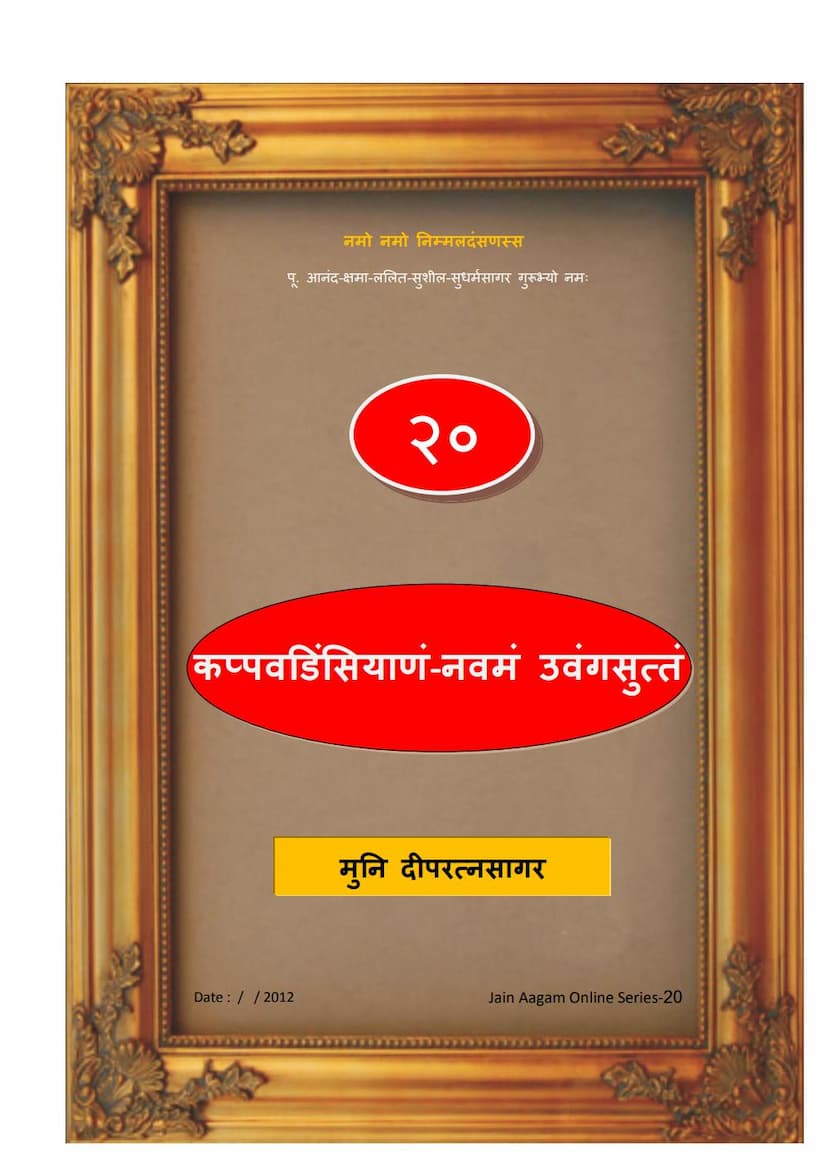Agam 20 Kappavadinsiyanam Navamam Uvvangsuttam Mulam PDF File
Added to library: September 1, 2025

Summary
Here's a comprehensive summary in English of the provided Jain text, focusing on the "Kappavaddisiyanam" (also transliterated as Kappavadinsiyanam) text from Agam 20:
Book Title: Agam 20 Kappavadinsiyanam Navamam Uvvangsuttam Mulam Author: Dipratnasagar, Deepratnasagar Publisher: Deepratnasagar Series: Jain Aagam online Series-20
Overview:
This text is the ninth Upanga, "Kappavadinsiyanam" (meaning "related to the Kappas" or heavenly realms/life-spans), within the Jain Agamas, specifically presented as part of Agam 20. The text, as indicated by its structure and content, details the lives and eventual liberation of ten individuals, all born as princes and later becoming ascetics, who ultimately attain salvation. The narrative highlights their spiritual journeys, emphasizing adherence to Jain principles, ascetic practices, and the cycle of rebirth and liberation. The content is attributed to the teachings of Lord Mahavira, as conveyed to his disciple, Jamboo.
Key Sections and Content:
The text is structured into ten chapters (adhyayana) or sections, each detailing the story of one individual. The provided excerpt focuses on the first two chapters, "Padama" (Padmam) and "Mahapadama" (Mahapadmam), and then provides a summary for the remaining eight.
-
Introduction (Page 1-2):
- The text begins with salutations to the pure vision (Nirmal Darshan) and spiritual preceptors.
- It introduces Agam 20 and the "Kappavadinsiyanam" as the ninth Upanga.
- A table of contents (Grathanukramo) lists the ten chapters: Padama, Mahapadama, Bhadra, Subhadra, Padmabhadra, Padmasena, Padmagupta, Nalini Gupta, Ananda, and Nandana.
-
First Chapter: Padama (Page 3):
- The chapter begins with a question posed by Bhagavan Mahavira to his disciple Jamboo, establishing the context of the "Kappavadinsiyanam."
- It is confirmed that Lord Mahavira taught ten chapters within this Upanga.
- The first chapter, "Padama," focuses on the story of a prince named Padama.
- Narrative of Padama:
- The story is set in the city of Champa during the reign of King Kunika and his queen, Chullamatrika Kali.
- Queen Kali had a son named Kala Kumar.
- Kala Kumar's queen was Padmavati.
- Queen Padmavati dreamt of seeing a lion, indicating a significant birth.
- She gave birth to a son, whom they named Padama, after the lotus (Padma) and because he was the son of Kala Kumar and Padmavati.
- The narrative then follows Padama's life, mirroring the spiritual journey of a figure named "Mahabala" (presumably detailed in another scripture). This includes his renunciation, becoming an ascetic, practicing austerities (fasts like Chaturth, Shashtam, Dasham, Dwadash, and half-month fasts), and meditating.
- After a significant period of asceticism and devotion, Padama passed away.
- Upon his death, he was reborn as a celestial being in the Shaudharma heaven, with a lifespan of two Sagaropamas (a unit of cosmic time in Jainism).
- Confirmation of Liberation: The text states that this Padama, as a celestial being, will eventually be reborn in Mahavideha Kshetra (a continent where liberation is easier) and will attain liberation (Siddhi) there.
- The first chapter concludes, summarizing the teachings about Padama.
-
Second Chapter: Mahapadama (Page 4):
- This chapter, "Mahapadama," follows a similar structure to the first.
- Narrative of Mahapadama:
- The setting remains the same: Champa, King Kunika, and Queen Chullamatrika Kali.
- However, this time, Queen Kali's son is named Sukala Kumar, and his queen is Mahapadama.
- Queen Mahapadama also has a significant dream (similar to Padmavati's).
- She gives birth to a son who is named Mahapadama.
- Similar to the first chapter, the narrative indicates that this Mahapadama will also attain liberation.
- Heavenly Rebirth: He is reborn in the Ishana heaven, with a longer lifespan than Padama.
- The second chapter concludes, summarizing the teachings about Mahapadama.
-
Summary of Chapters 3-10 (Page 4):
- The text explicitly states that the remaining eight chapters (3 to 10) follow a similar pattern.
- The individuals are referred to as "sons" of Kala Kumar (or through similar lineage connections, indicated by "mayao sarisanamavo kalainam dasannam puttanam").
- The names of these individuals are mentioned in sequence, and their rebirths in different celestial realms are listed in order, culminating in their eventual rebirth in Mahavideha Kshetra for final liberation.
- The specific heavenly realms mentioned are: Shaudharma, Ishana, Sanatkumara, Mahendra, Brahmaloka, Lantara, Mahashukra, Sahasrara, Prana, and Achyuta.
- It's noted that they all have "utmost lifespan" (utkosha sthiti) in these celestial realms.
Significance and Themes:
- The Power of Asceticism and Devotion: The text underscores the importance of practicing austerities, meditation, and devotion (Sāmayika, etc.) for spiritual progress and the eventual attainment of liberation.
- Cycle of Birth, Death, and Rebirth: It clearly illustrates the Jain concept of karma and rebirth, where actions in one life determine the circumstances of the next, including rebirth in celestial realms.
- The Path to Liberation (Moksha): The ultimate goal for these ten individuals is liberation, which is achieved through a combination of rigorous ascetic practices and the eventual birth in Mahavideha Kshetra, a place conducive to ultimate spiritual realization.
- Agamic Authority: The text reinforces the teachings of Lord Mahavira as the source of this spiritual knowledge.
- Genealogy and Lineage: The stories are grounded in the royal lineage of Champa, adding a historical and narrative dimension.
In essence, "Kappavadinsiyanam" is a profound Jain scripture that, through the lives of ten spiritual aspirants, elaborates on the path to liberation, the principles of asceticism, and the celestial realms within the framework of Jain cosmology.